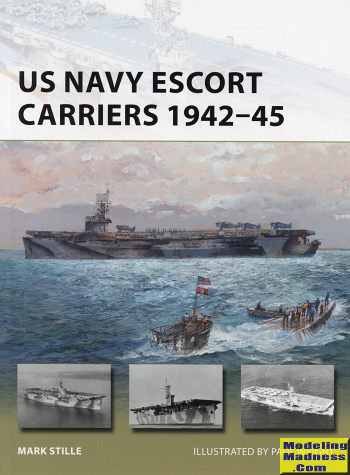 One of the
major issues that faced the Allies during WWII in the battle of the Atlantic,
was the lack of air cover. The solution to this was the aircraft carrier. But
there were not many around and these were generally needed for high value
convoys, such as ferrying troops and couldn't be spared for standard convoy
support.
One of the
major issues that faced the Allies during WWII in the battle of the Atlantic,
was the lack of air cover. The solution to this was the aircraft carrier. But
there were not many around and these were generally needed for high value
convoys, such as ferrying troops and couldn't be spared for standard convoy
support.
The British tried modifying ships with catapulted Hurricanes to fend off
long range German bombers, but this was minimally successful and wasn't able to
do anything about the biggest threat: U-boats. The US came up with the idea of a
small aircraft carrier, built on a merchant ship hull that would carry a small
number of aircraft. These would be used for either convoy escorts or to cruise
where there was known U-boat activity. Thanks to breaking the Enigma code, the
Allies were pretty well aware of where these boats concentrated.
Backing up a bit, the US Navy did not want these ships. However,
President Roosevelt was convinced of their usefulness and prior to the US entry
into the war directed that the type be built. The first one, the USS Long Island
was used as much as proof of concept as anything and after several modifications
to it and her sister ship USS Charger, the Navy had a good idea what worked and
what didn't. Thus began the construction of what turned out to be a much more
useful ship than was originally envisioned.
Not only were they good for escorts, but they frequently took the place
of fleet carriers in amphibious landing operations. They provided an air field
for ground attack operations early in a campaign and were widely used in the
Pacific for this purpose. Interestingly, these ships were most widely used to
ferry aircraft as they could hold a respectable number of aircraft on deck and
in the hangar. In fact, many escorts never saw any combat at all and spent their
career in the Pacific in this important duty. On the return trip they brought
back worn out or damaged planes for refurbishment and use as trainers.
The book covers the development of the type, their use in combat
operations, as well as a breakdown of the various classes. Each ship is listed
with basic stats and their ultimate fate. Some were sunk but many survived to
either be scrapped or turned into other vessel types. There is, of course a lot
more, but I don't want to give away everything. This is all superbly illustrated
by the art of Paul Wright and is full of great period photographs.
I really like this series and for me, it is one of the best that Osprey
produces. This is another winner and as such, highly recommended.
November 2017
Copyright ModelingMadness.com. All rights reserved.
For more on the complete line of Osprey books, visit
http://www.ospreypublishing.com
If you would like your product reviewed fairly and
fairly quickly, please
contact
the editor or see other details in the
Note to
Contributors.
 One of the
major issues that faced the Allies during WWII in the battle of the Atlantic,
was the lack of air cover. The solution to this was the aircraft carrier. But
there were not many around and these were generally needed for high value
convoys, such as ferrying troops and couldn't be spared for standard convoy
support.
One of the
major issues that faced the Allies during WWII in the battle of the Atlantic,
was the lack of air cover. The solution to this was the aircraft carrier. But
there were not many around and these were generally needed for high value
convoys, such as ferrying troops and couldn't be spared for standard convoy
support.